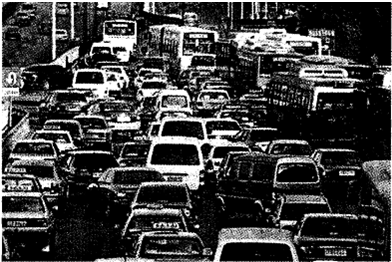题目内容
Traffic jam and cities, it seems, go hand in hand. Everyone complains about being stuck in traffic; but, like the weather, no one seems to do anything about it. In particular, traffic engineers, transportation planners, and public officials responsible for transportation systems in large cities are frequently criticized for failing to solve traffic jam.
But is traffic jam a sign of failure? Long queues at restaurants or theater box offices are seen as signs of success. Should transportation systems be viewed any differently? I think we should recognize that traffic jam is an unpreventable by-product of successful cities, and view the “traffic problem” in a different light.
Cities exist because they promote social interactions and economic transactions.
Traffic jam occurs where there are lots of people but limited spaces. Culturally and economically successful cities have the worst traffic problems, while decaying cities don’t have much traffic. New York and Los Angeles are America’s most crowded cities. But if you want access to major brokerage houses (经纪行), you will find them easier to reach in crowded New York than in any other large cities. And if your firm needs access to post-production film editors or satellite-guidance engineers, you will reach them more quickly through the crowded freeways of LA than through less crowded roads elsewhere.
Despite traffic jam, a larger number and wider variety of social interactions and economic transactions can be made perfect in large, crowded cities than elsewhere. Seen in this light, traffic jam is an unfortunate consequence of prosperity, not a cause of economic decline and urban decay.
So while we can consider traffic jam as increasing costs on the areas of big cities, the costs of inaccessibility (交通不便) in uncrowded places are almost certainly greater.
There is no doubt that traffic jam brings the terrible economic and environmental damage in places like Bangkok, Jakarta, and Lagos. But mobility is far higher and traffic jam levels are far lower here in the US, even in our most crowded cities. That’s why, for now, we don’t see people and capital streaming out of San Francisco and Chicago, heading for cities like California, and Illinois.
- 1.
We can conclude from the first paragraph that_______.
- A.traffic jam and weather are the two factors preventing the development of the big city
- B.traffic jam seems to be very difficult to deal with
- C.if traffic engineers try their best, traffic jam can be solved
- D.public officials are always criticized for misusing their power
- A.
- 2.
According to the passage, what’s the author’s opinion towards traffic jam?_____
- A.In cities, traffic jam is unavoidable.
- B.Traffic jam is both a sign of failure and a sign of success.
- C.Traffic jam is the consequence of successful cities.
- D.For a successful city, traffic jam is not unpreventable.
- A.
- 3.
By saying “decaying” (in Para. 4), the writer probably means_______.
- A.declining
- B.developing
- C.rich and successful
- D.strong and healthy
- A.
- 4.
According to this article, which statement about “New York” and “Los Angeles” is true? _____
- A.The traffic jam in the two cities has been worsened.
- B.New York and Los Angeles are the most successful cities in the US
- C.It is easier to reach major brokerage houses in the two cities than in other cities.
- D.Despite the traffic jam in LA,you'll find a satellite-guidance engineer more quickly there.
- A.
- 5.
What can we learn from the last paragraph? _______
- A.California is as crowded and successful as San Francisco.
- B.The traffic jam in San Francisco has resulted in the capital becoming empty.
- C.The traffic jam level in Jakarta is lower than that in the US.
- D.Traffic jam has caused terrible bad effects in cities such as Bangkok and Lagos.
- A.
1.B。 推理判断题。第一段第一句。城市和交通堵塞是相伴而生的。
2.C。 作者观点题。从第二段第四个句子可知作者的明确观点。交通堵塞本身就是发达城市发展中不可预测的副产品。
3.A。词义猜测题。由上文对比可知,成功的城市存在最糟糕的交通问题,相反的情况是衰退的城市没有太多交通堵塞。
4.D。 推理判断题。由第四段可知。
5.D。 段落大意题。由最后一段第一个主题句可知。

 开心练习课课练与单元检测系列答案
开心练习课课练与单元检测系列答案Traffic jam and cities, it seems, go hand in hand. Everyone complains about being stuck in traffic; but, like the weather, no one seems to do anything about it. In particular, traffic engineers, transportation planners, and public officials responsible for transportation systems in large cities are frequently criticized for failing to solve traffic jam.
But is traffic jam a sign of failure? Long queues at restaurants or theater box offices are seen as signs of success. Should transportation systems be viewed any differently? I think we should recognize that traffic jam is an unpreventable by-product of successful cities, and view the “traffic problem” in a different light.
Cities exist because they promote social interactions and economic transactions.
Traffic jam occurs where there are lots of people but limited spaces. Culturally and economically successful cities have the worst traffic problems, while decaying cities don’t have much traffic. New York and Los Angeles are America’s most crowded cities. But if you want access to major brokerage houses (经纪行), you will find them easier to reach in crowded New York than in any other large cities. And if your firm needs access to post-production film editors or satellite-guidance engineers, you will reach them more quickly through the crowded freeways of LA than through less crowded roads elsewhere.
Despite traffic jam, a larger number and wider variety of social interactions and economic transactions can be made perfect in large, crowded cities than elsewhere. Seen in this light, traffic jam is an unfortunate consequence of prosperity, not a cause of economic decline and urban decay.
So while we can consider traffic jam as increasing costs on the areas of big cities, the costs of inaccessibility (交通不便) in uncrowded places are almost certainly greater.
There is no doubt that traffic jam brings the terrible economic and environmental damage in places like Bangkok, Jakarta, and Lagos. But mobility is far higher and traffic jam levels are far lower here in the US, even in our most crowded cities. That’s why, for now, we don’t see people and capital streaming out of San Francisco and Chicago, heading for cities like California, and Illinois.
【小题1】 We can conclude from the first paragraph that_______.
| A.traffic jam and weather are the two factors preventing the development of the big city |
| B.traffic jam seems to be very difficult to deal with |
| C.if traffic engineers try their best, traffic jam can be solved |
| D.public officials are always criticized for misusing their power |
| A.In cities, traffic jam is unavoidable. |
| B.Traffic jam is both a sign of failure and a sign of success. |
| C.Traffic jam is the consequence of successful cities. |
| D.For a successful city, traffic jam is not unpreventable. |
| A.declining | B.developing |
| C.rich and successful | D.strong and healthy |
A. The traffic jam in the two cities has been worsened.
B. New York and Los Angeles are the most successful cities in the USA.
C. It is easier to reach major brokerage houses in the two cities than in other cities.
D. Despite the traffic jam in LA, you’ll find a satellite-guidance engineer more quickly there.
【小题5】What can we learn from the last paragraph? _______
| A.California is as crowded and successful as San Francisco. |
| B.The traffic jam in San Francisco has resulted in the capital becoming empty. |
| C.The traffic jam level in Jakarta is lower than that in the US. |
| D.Traffic jam has caused terrible bad effects in cities such as Bangkok and Lagos. |
—You are late again,Tom?
—Sorry,but I got ________a heavy traffic jam.
|
A.caught in |
B.taken in |
C.put off |
D.held by |
